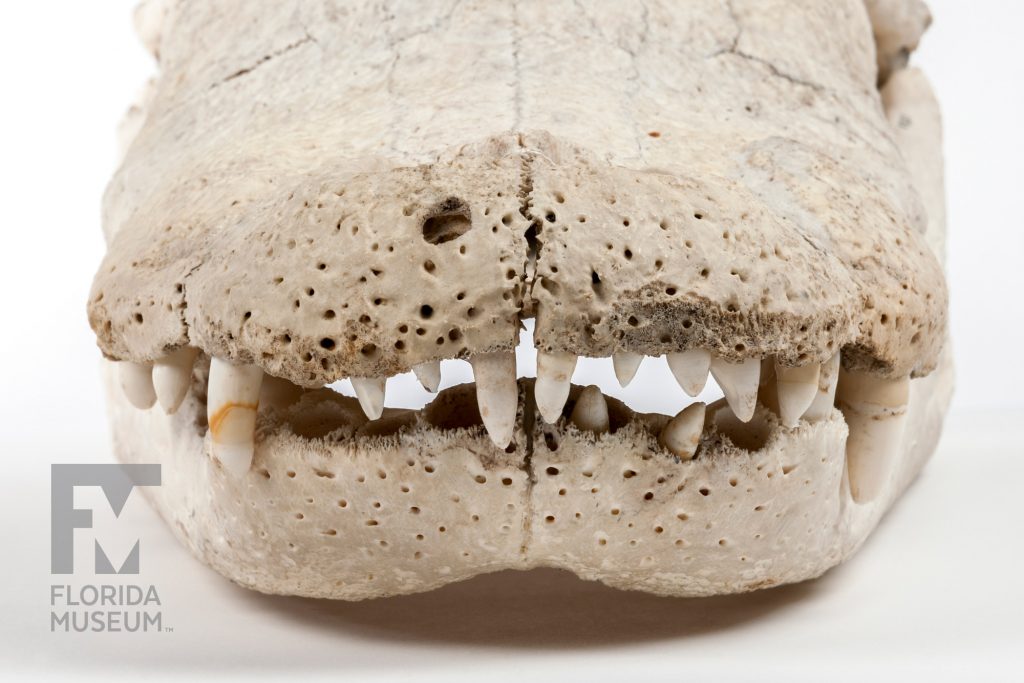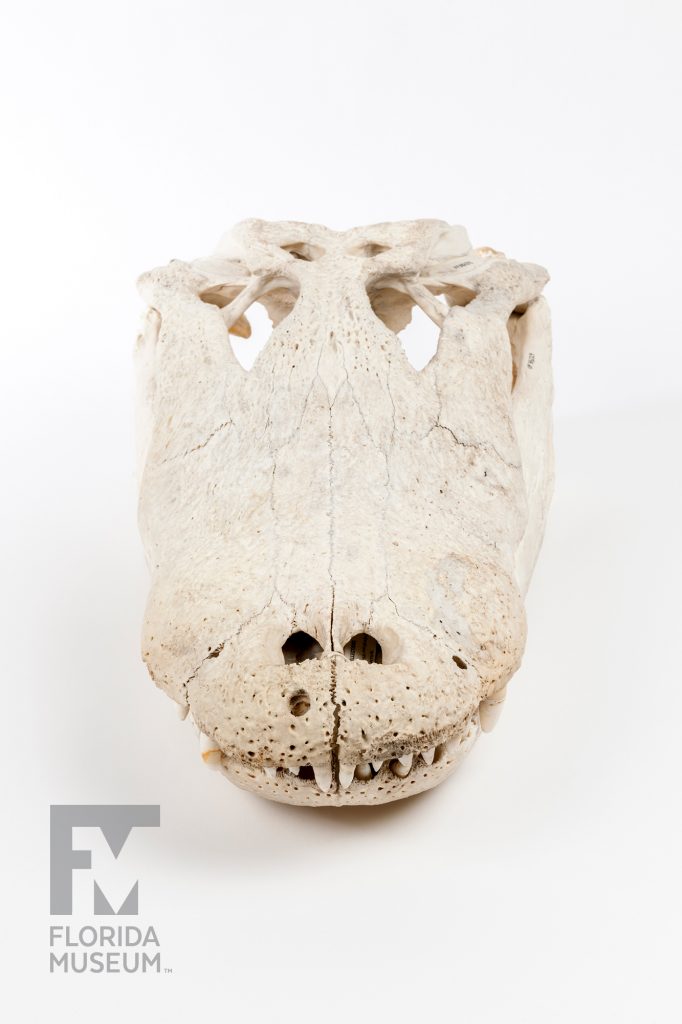This object is on permanent display in the Museum’s Exploring Our World exhibit, located in the “Museum Research & Collections” section.
Summary
Albert’s Skull (Alligator mississippiensis)
From Alachua Co., Florida
UF “Albert” mascot from Lake Alice, Oct. 1974
Collection
Story
In the 1950s, a caged area was developed on campus at the University of Florida between the Florida Auditorium and what was to become Turlington Hall. That area was then filled with small alligators. Initially, these gators were probably 4-foot animals and they didn’t receive very good overview and many of them were killed, injured, stolen, escaped…it wasn’t a very good situation.
In 1957, Ross Allen, who was a reptilian entrepreneur and benefactor to the University, operated the Ross Allen Reptile Institute at Silver Springs, Florida. He donated the first large alligator to the University of Florida and he donated several others. That animal became known as “Albert” and the large animal didn’t seem to get picked on as much as the smaller ones. However, in one instance, the Florida State University crew managed to paint it right before a Florida vs. Florida State University football game.
They would actually move this large gator in a glass enclosure to the field during football games and other events — so it was indeed a privileged gator from that respect. However, by the 1960s it was a bit of a challenge to keep moving this animal around; it wasn’t always perfect living conditions for the animals. So it was not appropriate to keep it live on campus every day in the open. Actually, it was released into Lake Alice.
So, that created new opportunities. We see photographs from 1964 with smaller alligators so we know they were being used in some ways, at least, in events to highlight Albert and Alberta as mascots. But basically we had an individual from California who became known as “Gator Man” who took a liking to one of the Alberts in Lake Alice. It was a large adult alligator and he suddenly began to wade into the water to feed it marshmallows, even lying on top of the gator.
One day he noticed that the alligator was lying lethargically on the shore of Lake Alice and when he approached it he determined that the alligator was quite ill. Therefore they transported this Albert to the University of Florida School of Veterinary Medicine whereupon the animal died. And, upon death, they conducted a necropsy and found a pop bottle in the intestine which had blocked the digestive tract.
Upon that, “Mr. Gator” (in a sense) left the state. He went to Switzerland and became quite active in another career. But they stopped using live gators in their performances and switched to mascots which were in costume. We see Albert and Alberta at a lot of our University of Florida events and they were considered the top mascots for the entire nation during one competition. And it’s the only mascot with both genders represented as far as we know.
Max Nickerson
Curator, Herpetology*
Florida Museum of Natural History
Exhibit
On display Sept. 23, 2017-Jan. 7, 2018, Rare, Beautiful & Fascinating: 100 Years @FloridaMuseum celebrated the Museum’s rich history. Each Museum collection was asked to contribute its most interesting items and share the stories that make them special. Though the physical exhibit is closed, this companion website remains online, providing an opportunity to experience the Florida Museum’s most treasured specimens.
Exhibit Area: Always on Display
 Want to see more? Explore more than 300 breathtaking color photos of plants, animals, fossils and cultural heritage materials from the Florida Museum of Natural History’s collections in the award-winning book All Things Beautiful available from the University Press of Florida.
Want to see more? Explore more than 300 breathtaking color photos of plants, animals, fossils and cultural heritage materials from the Florida Museum of Natural History’s collections in the award-winning book All Things Beautiful available from the University Press of Florida.
*This title was accurate at the time the exhibit was on display in 2017. Please visit the collection website to verify current staff and student information.

